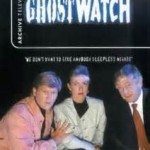When I was a kid, I got a copy of Orson Welles’s radio play adaptation of War of the Worlds. I had heard of it before and wanted to hear it myself. For those not aware, this was a 1938 Halloween production of H.G. Wells’ novel. Orson set it in the modern day, and the first half of the play was presented as a news report breaking into a radio show to tell the tale of an alien invasion. Due to the authenticity of the production, listeners who came in late thought that aliens really were invading New Jersey and people across the nation panicked. It was one of the best-documented cases of mass hysteria and crowd delusion ever.
Since then, there have been other shows that have used the live broadcast method to tell their story. Most go to great lengths to remind the audience that they are fiction. But even with this effort there will always be people that believe they are watching something real.
One of the most infamous of these was the BBC’s 1992 production Ghostwatch.
Ghostwatch was a 90 minute broadcast on Halloween, and was presented as a live investigation of a haunting. The producers’ intent was to create an experience much like the one Welles inadvertently created 54 years earlier. The show was listed in the Radio Times as a drama with a cast list, and there were credits at the beginning and end.
The story was that a team of ghost hunters and journalists were doing a live on-air investigation of a reported haunting in a London suburb. While the team on site was doing the investigation, back at the studio the evidence was being analyzed by a skeptical psychologist and the BBC host. A phone line had been set up so that the viewing audience could call in with their own theories.
Most of the first half hour was interviews with the family and backstory, with not much happening. The young girls in the house were terrified of a ghost they had named Pipes, due to the fact that their mother had explained strange noises as just being the pipes. As the investigation goes on, events start happening that unnerve the investigators, including an attack on one of the girls that requires her to be rushed to the hospital.
Eventually the investigation learns that the house was owned by a 19th century child murderer, and it is his ghost haunting the house. The attacks get worse, and one of the ghost experts realize that by broadcasting the investigation live they have created a massive séance that has supercharged Pipes. He proceeds to drag one of the Journalists, Sarah Greene, into a cubby hole, with the implication that he has killed her. Pipes escapes the house and appears at the BBC studio, with the suggestion that he can enter any home watching the show. He creates havoc in the studio and the final shot of the show has him possessing the host, Michael Parkinson.
While the BBC did take steps to promote the show as a drama, a huge portion of the viewing audience thought they were seeing a real event. Several factors played into this.
Due to a program overrun on another channel, a large percentage of the viewing audience tuned in late, thus not seeing the opening letting them know this was a drama, instead of a real event. The show also had a call-in number for people to use to share their own theories about the haunting. Once callers got through, they were reminded that the show was fictional, but encouraged to share any ghost stories they knew. As the show got more intense, more people called in, resulting in many callers getting a busy signal.
The way the show was shot was brilliant for the theme, and also added to the realism. They had an actor on set named Keith Ferrari who played Pipes. Ferrari was made up to be scarred and missing an eye. He would at times be in the background of a shot out of the camera’s focus range, or he would be standing in a corner when a quick pan occurred. Since the camera never focused on him, people who did notice him were sure they had seen the ghost.
But the main reason people believed it was real was that the cast included real BBC presenters playing themselves, including Michael Parkinson, Sarah Greene, Mike Smith, and Craig Charles. To give context for an American audience, this would be the equivalent of having Anderson Cooper, Matt Lauer, Ann Curry, and Al Roker star as themselves. And yes, this show was produced after Red Dwarf premiered, but Craig Charles’s career on British Television included being a frequent presenter, so his presence did not seem odd.
I suppose it goes without saying that there was a public outcry when the BBC, in response to viewer concerns, pointed out that the show was a drama. There were several complaints filed against the BBC, including one claiming that an 18 year old with severe learning disabilities had committed suicide after seeing the show. The complaint was dismissed, although the BBC did issue an apology. Due to the controversy, Ghostwatch has never been rebroadcast in the UK. It is available on DVD, however. Last month, a documentary¸ Ghostwatch: Behind the Curtains, was released in the UK on DVD, interviewing most of the participants in the original broadcast.
In spite of only being aired once, Ghostwatch is credited with being an inspiration for shows that blur the line between fact and fiction, such as The Blair Witch Project and modern ghost-hunting shows. The latter is due to the fact that even though it was a fictional program, Ghostwatch presented investigation techniques, such as night vision cameras and thermal imaging, that have become standard fair today.
So there you have Ghostwatch, a little-known gem that really does deserve a wider audience.

